Business Environment Analysis of McDonald's: A Comprehensive Report
VerifiedAdded on 2020/10/22
|17
|5067
|56
Report
AI Summary
This report provides a comprehensive analysis of McDonald's business environment. It begins by defining the business environment and its impact on organizational performance, using McDonald's as a case study. The report explores different types of organizations (public, private, and voluntary), their legal structures, and purposes, with examples such as Crown Prosecution Services and Oxfam. It then examines the size and scope of various companies, including McDonald's, and their missions, visions, and objectives. The core of the report focuses on the interrelation of different organizational functions (HR, marketing, production, finance, and R&D) and their links to organizational structure and objectives. It highlights the importance of coordination between departments to achieve company goals. The report further delves into the macro-environmental factors impacting business operations, followed by a SWOT analysis to identify McDonald's strengths, weaknesses, and the interplay between these factors and the external environment. The conclusion summarizes the key findings and insights from the analysis.
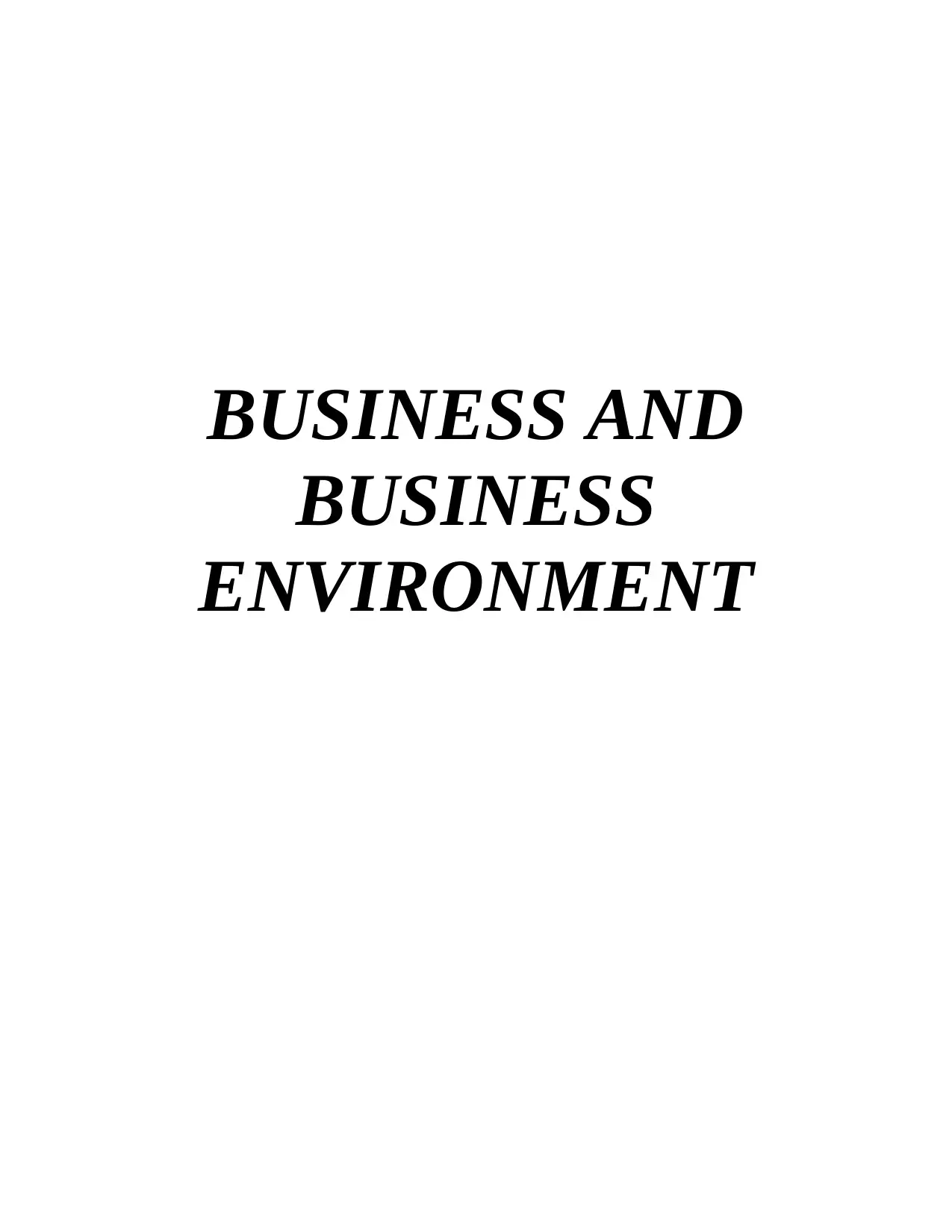
BUSINESS AND
BUSINESS
ENVIRONMENT
BUSINESS
ENVIRONMENT
Paraphrase This Document
Need a fresh take? Get an instant paraphrase of this document with our AI Paraphraser
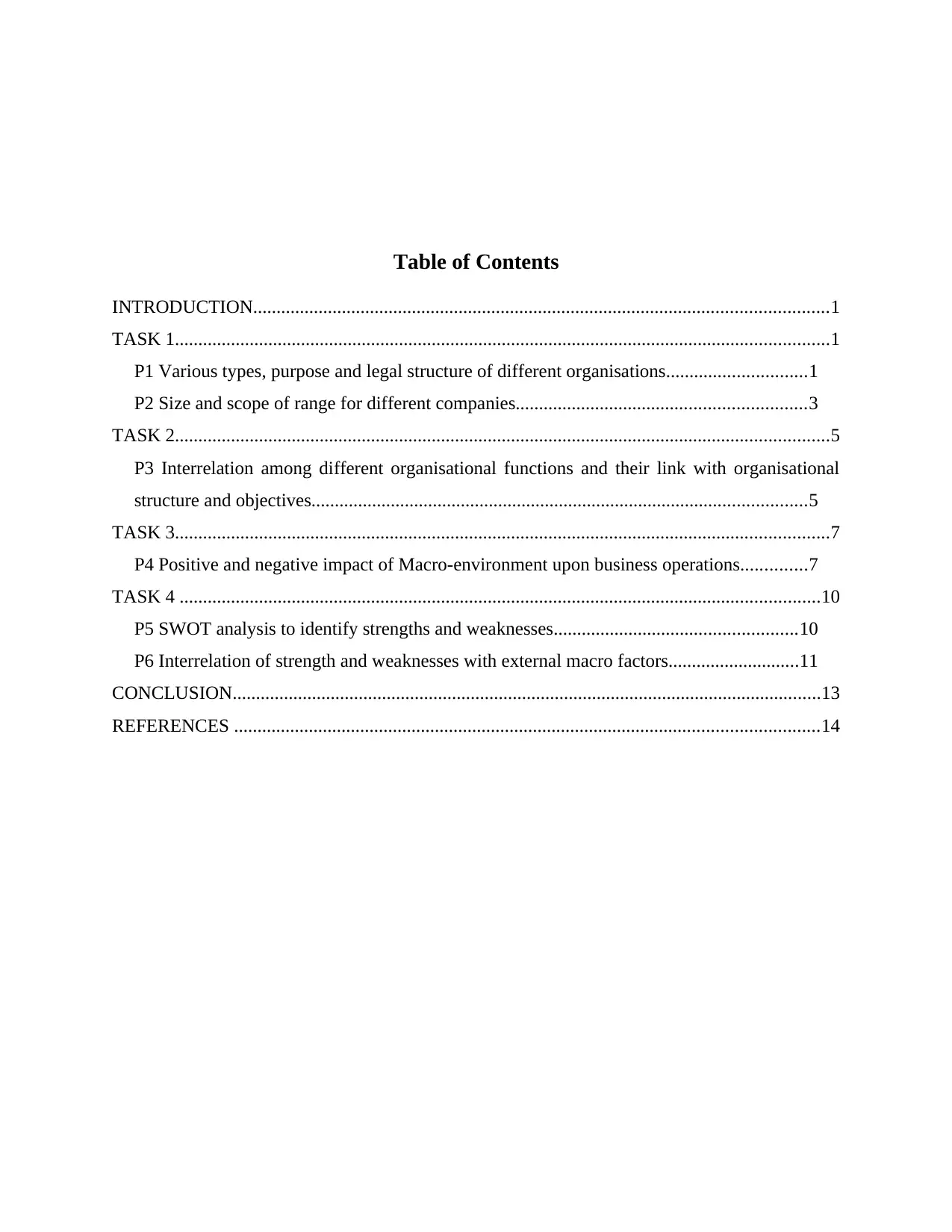
Table of Contents
INTRODUCTION...........................................................................................................................1
TASK 1............................................................................................................................................1
P1 Various types, purpose and legal structure of different organisations..............................1
P2 Size and scope of range for different companies..............................................................3
TASK 2............................................................................................................................................5
P3 Interrelation among different organisational functions and their link with organisational
structure and objectives..........................................................................................................5
TASK 3............................................................................................................................................7
P4 Positive and negative impact of Macro-environment upon business operations..............7
TASK 4 .........................................................................................................................................10
P5 SWOT analysis to identify strengths and weaknesses....................................................10
P6 Interrelation of strength and weaknesses with external macro factors............................11
CONCLUSION..............................................................................................................................13
REFERENCES .............................................................................................................................14
INTRODUCTION...........................................................................................................................1
TASK 1............................................................................................................................................1
P1 Various types, purpose and legal structure of different organisations..............................1
P2 Size and scope of range for different companies..............................................................3
TASK 2............................................................................................................................................5
P3 Interrelation among different organisational functions and their link with organisational
structure and objectives..........................................................................................................5
TASK 3............................................................................................................................................7
P4 Positive and negative impact of Macro-environment upon business operations..............7
TASK 4 .........................................................................................................................................10
P5 SWOT analysis to identify strengths and weaknesses....................................................10
P6 Interrelation of strength and weaknesses with external macro factors............................11
CONCLUSION..............................................................................................................................13
REFERENCES .............................................................................................................................14

⊘ This is a preview!⊘
Do you want full access?
Subscribe today to unlock all pages.

Trusted by 1+ million students worldwide
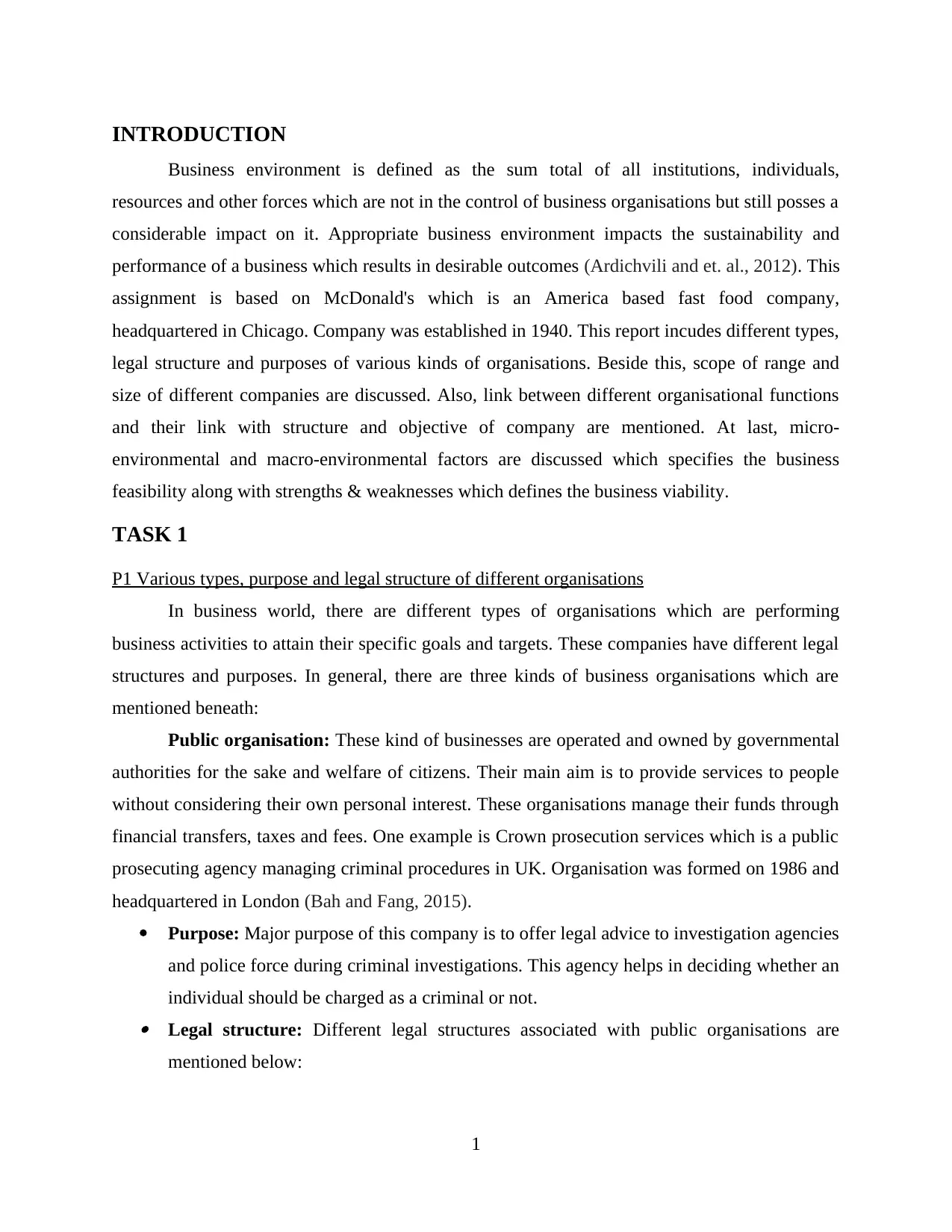
INTRODUCTION
Business environment is defined as the sum total of all institutions, individuals,
resources and other forces which are not in the control of business organisations but still posses a
considerable impact on it. Appropriate business environment impacts the sustainability and
performance of a business which results in desirable outcomes (Ardichvili and et. al., 2012). This
assignment is based on McDonald's which is an America based fast food company,
headquartered in Chicago. Company was established in 1940. This report incudes different types,
legal structure and purposes of various kinds of organisations. Beside this, scope of range and
size of different companies are discussed. Also, link between different organisational functions
and their link with structure and objective of company are mentioned. At last, micro-
environmental and macro-environmental factors are discussed which specifies the business
feasibility along with strengths & weaknesses which defines the business viability.
TASK 1
P1 Various types, purpose and legal structure of different organisations
In business world, there are different types of organisations which are performing
business activities to attain their specific goals and targets. These companies have different legal
structures and purposes. In general, there are three kinds of business organisations which are
mentioned beneath:
Public organisation: These kind of businesses are operated and owned by governmental
authorities for the sake and welfare of citizens. Their main aim is to provide services to people
without considering their own personal interest. These organisations manage their funds through
financial transfers, taxes and fees. One example is Crown prosecution services which is a public
prosecuting agency managing criminal procedures in UK. Organisation was formed on 1986 and
headquartered in London (Bah and Fang, 2015).
Purpose: Major purpose of this company is to offer legal advice to investigation agencies
and police force during criminal investigations. This agency helps in deciding whether an
individual should be charged as a criminal or not. Legal structure: Different legal structures associated with public organisations are
mentioned below:
1
Business environment is defined as the sum total of all institutions, individuals,
resources and other forces which are not in the control of business organisations but still posses a
considerable impact on it. Appropriate business environment impacts the sustainability and
performance of a business which results in desirable outcomes (Ardichvili and et. al., 2012). This
assignment is based on McDonald's which is an America based fast food company,
headquartered in Chicago. Company was established in 1940. This report incudes different types,
legal structure and purposes of various kinds of organisations. Beside this, scope of range and
size of different companies are discussed. Also, link between different organisational functions
and their link with structure and objective of company are mentioned. At last, micro-
environmental and macro-environmental factors are discussed which specifies the business
feasibility along with strengths & weaknesses which defines the business viability.
TASK 1
P1 Various types, purpose and legal structure of different organisations
In business world, there are different types of organisations which are performing
business activities to attain their specific goals and targets. These companies have different legal
structures and purposes. In general, there are three kinds of business organisations which are
mentioned beneath:
Public organisation: These kind of businesses are operated and owned by governmental
authorities for the sake and welfare of citizens. Their main aim is to provide services to people
without considering their own personal interest. These organisations manage their funds through
financial transfers, taxes and fees. One example is Crown prosecution services which is a public
prosecuting agency managing criminal procedures in UK. Organisation was formed on 1986 and
headquartered in London (Bah and Fang, 2015).
Purpose: Major purpose of this company is to offer legal advice to investigation agencies
and police force during criminal investigations. This agency helps in deciding whether an
individual should be charged as a criminal or not. Legal structure: Different legal structures associated with public organisations are
mentioned below:
1
Paraphrase This Document
Need a fresh take? Get an instant paraphrase of this document with our AI Paraphraser
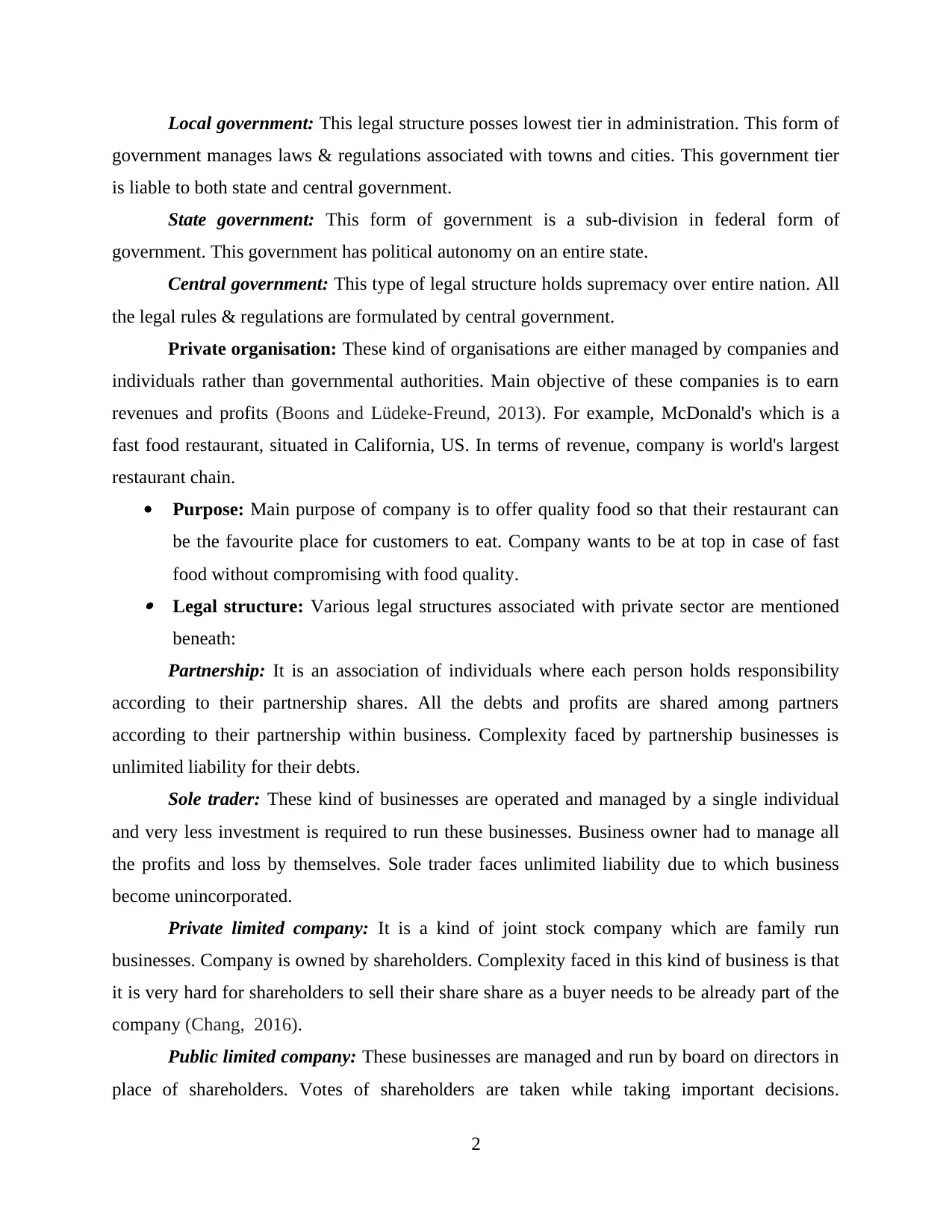
Local government: This legal structure posses lowest tier in administration. This form of
government manages laws & regulations associated with towns and cities. This government tier
is liable to both state and central government.
State government: This form of government is a sub-division in federal form of
government. This government has political autonomy on an entire state.
Central government: This type of legal structure holds supremacy over entire nation. All
the legal rules & regulations are formulated by central government.
Private organisation: These kind of organisations are either managed by companies and
individuals rather than governmental authorities. Main objective of these companies is to earn
revenues and profits (Boons and Lüdeke-Freund, 2013). For example, McDonald's which is a
fast food restaurant, situated in California, US. In terms of revenue, company is world's largest
restaurant chain.
Purpose: Main purpose of company is to offer quality food so that their restaurant can
be the favourite place for customers to eat. Company wants to be at top in case of fast
food without compromising with food quality. Legal structure: Various legal structures associated with private sector are mentioned
beneath:
Partnership: It is an association of individuals where each person holds responsibility
according to their partnership shares. All the debts and profits are shared among partners
according to their partnership within business. Complexity faced by partnership businesses is
unlimited liability for their debts.
Sole trader: These kind of businesses are operated and managed by a single individual
and very less investment is required to run these businesses. Business owner had to manage all
the profits and loss by themselves. Sole trader faces unlimited liability due to which business
become unincorporated.
Private limited company: It is a kind of joint stock company which are family run
businesses. Company is owned by shareholders. Complexity faced in this kind of business is that
it is very hard for shareholders to sell their share share as a buyer needs to be already part of the
company (Chang, 2016).
Public limited company: These businesses are managed and run by board on directors in
place of shareholders. Votes of shareholders are taken while taking important decisions.
2
government manages laws & regulations associated with towns and cities. This government tier
is liable to both state and central government.
State government: This form of government is a sub-division in federal form of
government. This government has political autonomy on an entire state.
Central government: This type of legal structure holds supremacy over entire nation. All
the legal rules & regulations are formulated by central government.
Private organisation: These kind of organisations are either managed by companies and
individuals rather than governmental authorities. Main objective of these companies is to earn
revenues and profits (Boons and Lüdeke-Freund, 2013). For example, McDonald's which is a
fast food restaurant, situated in California, US. In terms of revenue, company is world's largest
restaurant chain.
Purpose: Main purpose of company is to offer quality food so that their restaurant can
be the favourite place for customers to eat. Company wants to be at top in case of fast
food without compromising with food quality. Legal structure: Various legal structures associated with private sector are mentioned
beneath:
Partnership: It is an association of individuals where each person holds responsibility
according to their partnership shares. All the debts and profits are shared among partners
according to their partnership within business. Complexity faced by partnership businesses is
unlimited liability for their debts.
Sole trader: These kind of businesses are operated and managed by a single individual
and very less investment is required to run these businesses. Business owner had to manage all
the profits and loss by themselves. Sole trader faces unlimited liability due to which business
become unincorporated.
Private limited company: It is a kind of joint stock company which are family run
businesses. Company is owned by shareholders. Complexity faced in this kind of business is that
it is very hard for shareholders to sell their share share as a buyer needs to be already part of the
company (Chang, 2016).
Public limited company: These businesses are managed and run by board on directors in
place of shareholders. Votes of shareholders are taken while taking important decisions.
2
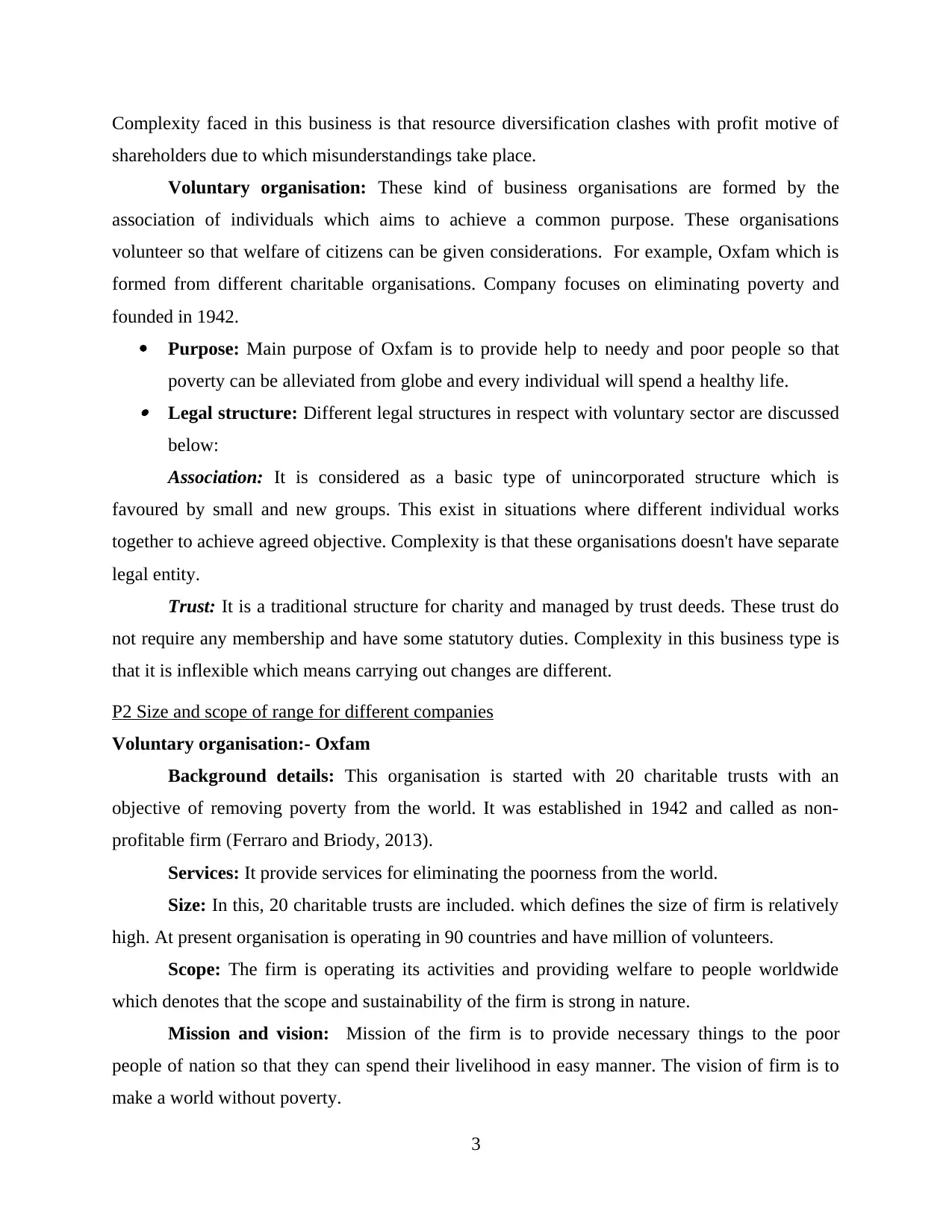
Complexity faced in this business is that resource diversification clashes with profit motive of
shareholders due to which misunderstandings take place.
Voluntary organisation: These kind of business organisations are formed by the
association of individuals which aims to achieve a common purpose. These organisations
volunteer so that welfare of citizens can be given considerations. For example, Oxfam which is
formed from different charitable organisations. Company focuses on eliminating poverty and
founded in 1942.
Purpose: Main purpose of Oxfam is to provide help to needy and poor people so that
poverty can be alleviated from globe and every individual will spend a healthy life. Legal structure: Different legal structures in respect with voluntary sector are discussed
below:
Association: It is considered as a basic type of unincorporated structure which is
favoured by small and new groups. This exist in situations where different individual works
together to achieve agreed objective. Complexity is that these organisations doesn't have separate
legal entity.
Trust: It is a traditional structure for charity and managed by trust deeds. These trust do
not require any membership and have some statutory duties. Complexity in this business type is
that it is inflexible which means carrying out changes are different.
P2 Size and scope of range for different companies
Voluntary organisation:- Oxfam
Background details: This organisation is started with 20 charitable trusts with an
objective of removing poverty from the world. It was established in 1942 and called as non-
profitable firm (Ferraro and Briody, 2013).
Services: It provide services for eliminating the poorness from the world.
Size: In this, 20 charitable trusts are included. which defines the size of firm is relatively
high. At present organisation is operating in 90 countries and have million of volunteers.
Scope: The firm is operating its activities and providing welfare to people worldwide
which denotes that the scope and sustainability of the firm is strong in nature.
Mission and vision: Mission of the firm is to provide necessary things to the poor
people of nation so that they can spend their livelihood in easy manner. The vision of firm is to
make a world without poverty.
3
shareholders due to which misunderstandings take place.
Voluntary organisation: These kind of business organisations are formed by the
association of individuals which aims to achieve a common purpose. These organisations
volunteer so that welfare of citizens can be given considerations. For example, Oxfam which is
formed from different charitable organisations. Company focuses on eliminating poverty and
founded in 1942.
Purpose: Main purpose of Oxfam is to provide help to needy and poor people so that
poverty can be alleviated from globe and every individual will spend a healthy life. Legal structure: Different legal structures in respect with voluntary sector are discussed
below:
Association: It is considered as a basic type of unincorporated structure which is
favoured by small and new groups. This exist in situations where different individual works
together to achieve agreed objective. Complexity is that these organisations doesn't have separate
legal entity.
Trust: It is a traditional structure for charity and managed by trust deeds. These trust do
not require any membership and have some statutory duties. Complexity in this business type is
that it is inflexible which means carrying out changes are different.
P2 Size and scope of range for different companies
Voluntary organisation:- Oxfam
Background details: This organisation is started with 20 charitable trusts with an
objective of removing poverty from the world. It was established in 1942 and called as non-
profitable firm (Ferraro and Briody, 2013).
Services: It provide services for eliminating the poorness from the world.
Size: In this, 20 charitable trusts are included. which defines the size of firm is relatively
high. At present organisation is operating in 90 countries and have million of volunteers.
Scope: The firm is operating its activities and providing welfare to people worldwide
which denotes that the scope and sustainability of the firm is strong in nature.
Mission and vision: Mission of the firm is to provide necessary things to the poor
people of nation so that they can spend their livelihood in easy manner. The vision of firm is to
make a world without poverty.
3
⊘ This is a preview!⊘
Do you want full access?
Subscribe today to unlock all pages.

Trusted by 1+ million students worldwide
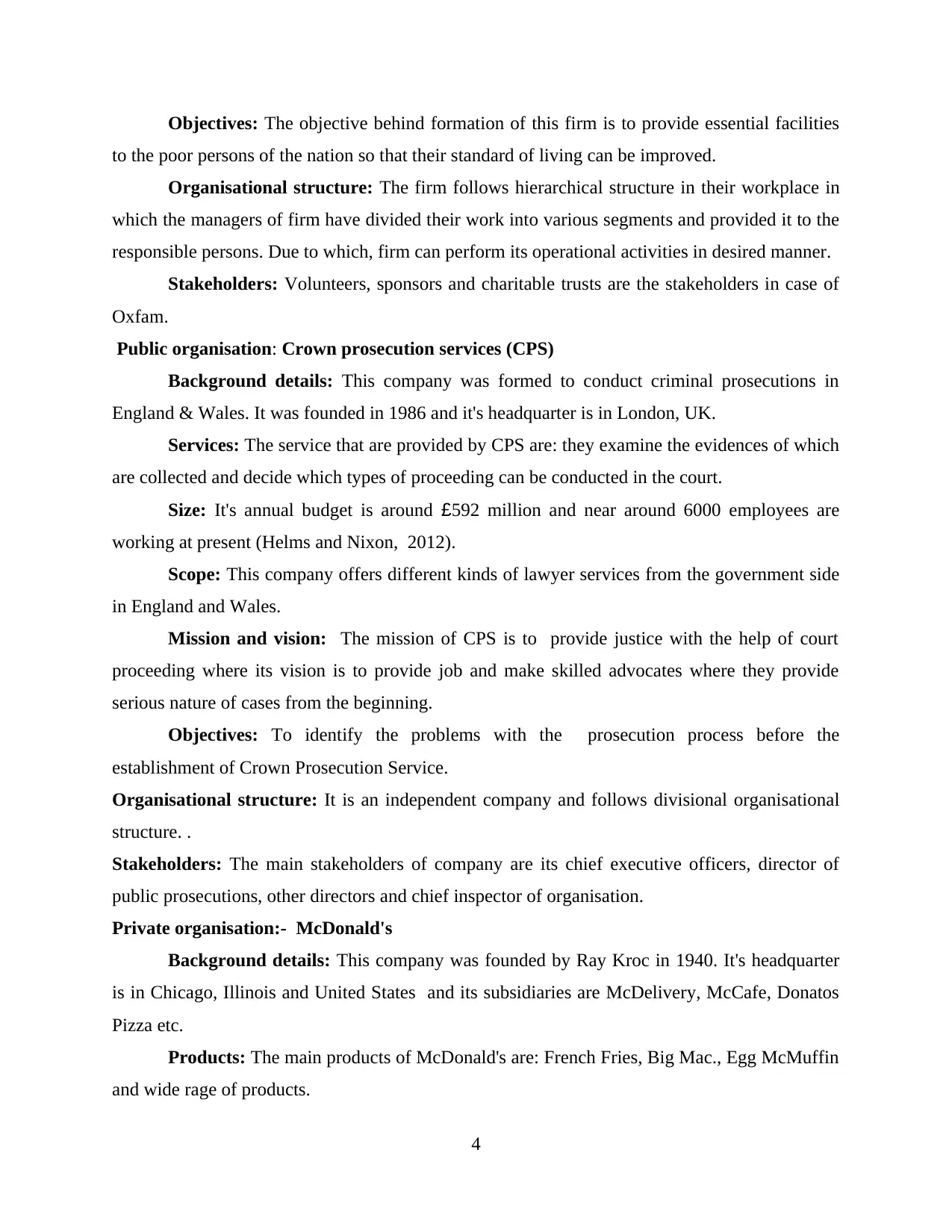
Objectives: The objective behind formation of this firm is to provide essential facilities
to the poor persons of the nation so that their standard of living can be improved.
Organisational structure: The firm follows hierarchical structure in their workplace in
which the managers of firm have divided their work into various segments and provided it to the
responsible persons. Due to which, firm can perform its operational activities in desired manner.
Stakeholders: Volunteers, sponsors and charitable trusts are the stakeholders in case of
Oxfam.
Public organisation: Crown prosecution services (CPS)
Background details: This company was formed to conduct criminal prosecutions in
England & Wales. It was founded in 1986 and it's headquarter is in London, UK.
Services: The service that are provided by CPS are: they examine the evidences of which
are collected and decide which types of proceeding can be conducted in the court.
Size: It's annual budget is around £592 million and near around 6000 employees are
working at present (Helms and Nixon, 2012).
Scope: This company offers different kinds of lawyer services from the government side
in England and Wales.
Mission and vision: The mission of CPS is to provide justice with the help of court
proceeding where its vision is to provide job and make skilled advocates where they provide
serious nature of cases from the beginning.
Objectives: To identify the problems with the prosecution process before the
establishment of Crown Prosecution Service.
Organisational structure: It is an independent company and follows divisional organisational
structure. .
Stakeholders: The main stakeholders of company are its chief executive officers, director of
public prosecutions, other directors and chief inspector of organisation.
Private organisation:- McDonald's
Background details: This company was founded by Ray Kroc in 1940. It's headquarter
is in Chicago, Illinois and United States and its subsidiaries are McDelivery, McCafe, Donatos
Pizza etc.
Products: The main products of McDonald's are: French Fries, Big Mac., Egg McMuffin
and wide rage of products.
4
to the poor persons of the nation so that their standard of living can be improved.
Organisational structure: The firm follows hierarchical structure in their workplace in
which the managers of firm have divided their work into various segments and provided it to the
responsible persons. Due to which, firm can perform its operational activities in desired manner.
Stakeholders: Volunteers, sponsors and charitable trusts are the stakeholders in case of
Oxfam.
Public organisation: Crown prosecution services (CPS)
Background details: This company was formed to conduct criminal prosecutions in
England & Wales. It was founded in 1986 and it's headquarter is in London, UK.
Services: The service that are provided by CPS are: they examine the evidences of which
are collected and decide which types of proceeding can be conducted in the court.
Size: It's annual budget is around £592 million and near around 6000 employees are
working at present (Helms and Nixon, 2012).
Scope: This company offers different kinds of lawyer services from the government side
in England and Wales.
Mission and vision: The mission of CPS is to provide justice with the help of court
proceeding where its vision is to provide job and make skilled advocates where they provide
serious nature of cases from the beginning.
Objectives: To identify the problems with the prosecution process before the
establishment of Crown Prosecution Service.
Organisational structure: It is an independent company and follows divisional organisational
structure. .
Stakeholders: The main stakeholders of company are its chief executive officers, director of
public prosecutions, other directors and chief inspector of organisation.
Private organisation:- McDonald's
Background details: This company was founded by Ray Kroc in 1940. It's headquarter
is in Chicago, Illinois and United States and its subsidiaries are McDelivery, McCafe, Donatos
Pizza etc.
Products: The main products of McDonald's are: French Fries, Big Mac., Egg McMuffin
and wide rage of products.
4
Paraphrase This Document
Need a fresh take? Get an instant paraphrase of this document with our AI Paraphraser
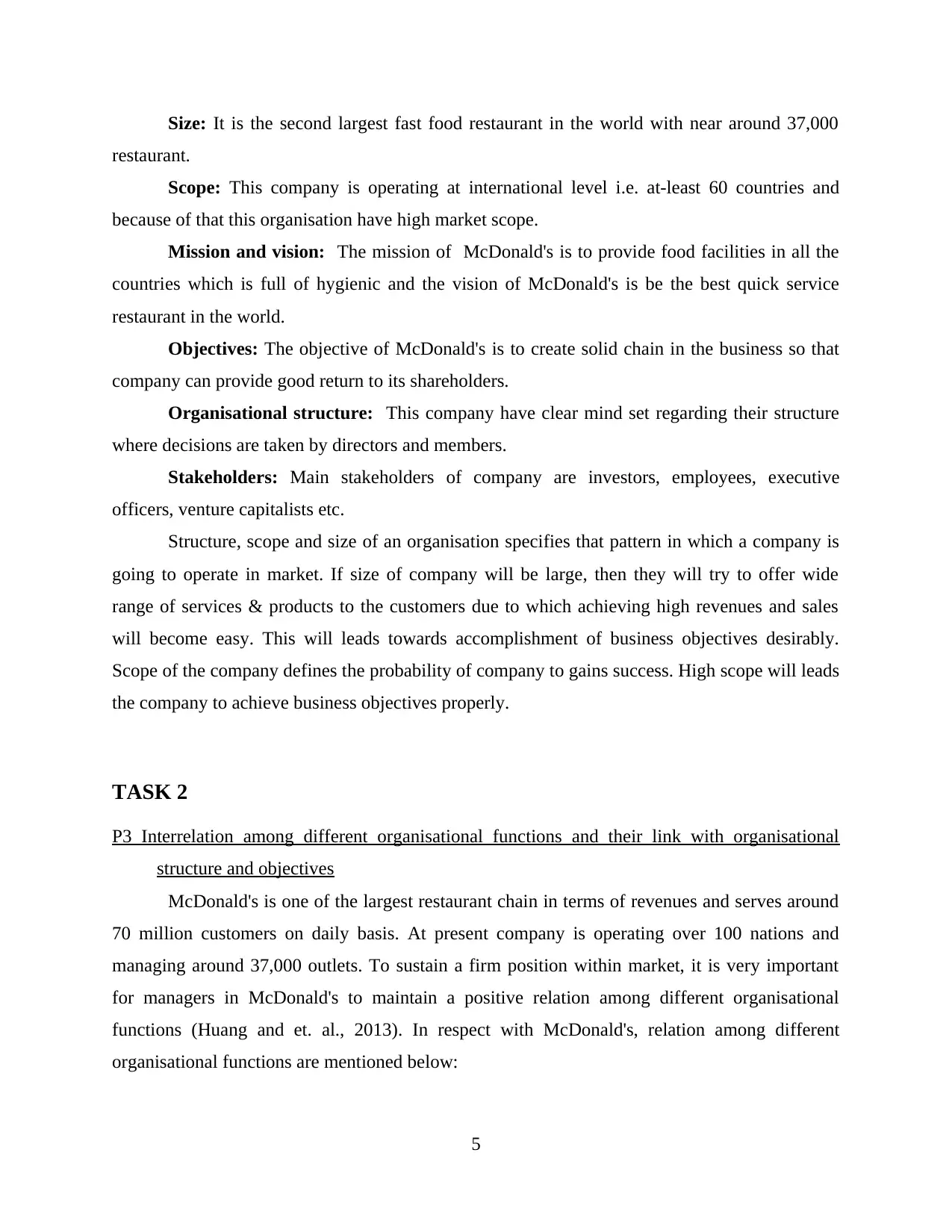
Size: It is the second largest fast food restaurant in the world with near around 37,000
restaurant.
Scope: This company is operating at international level i.e. at-least 60 countries and
because of that this organisation have high market scope.
Mission and vision: The mission of McDonald's is to provide food facilities in all the
countries which is full of hygienic and the vision of McDonald's is be the best quick service
restaurant in the world.
Objectives: The objective of McDonald's is to create solid chain in the business so that
company can provide good return to its shareholders.
Organisational structure: This company have clear mind set regarding their structure
where decisions are taken by directors and members.
Stakeholders: Main stakeholders of company are investors, employees, executive
officers, venture capitalists etc.
Structure, scope and size of an organisation specifies that pattern in which a company is
going to operate in market. If size of company will be large, then they will try to offer wide
range of services & products to the customers due to which achieving high revenues and sales
will become easy. This will leads towards accomplishment of business objectives desirably.
Scope of the company defines the probability of company to gains success. High scope will leads
the company to achieve business objectives properly.
TASK 2
P3 Interrelation among different organisational functions and their link with organisational
structure and objectives
McDonald's is one of the largest restaurant chain in terms of revenues and serves around
70 million customers on daily basis. At present company is operating over 100 nations and
managing around 37,000 outlets. To sustain a firm position within market, it is very important
for managers in McDonald's to maintain a positive relation among different organisational
functions (Huang and et. al., 2013). In respect with McDonald's, relation among different
organisational functions are mentioned below:
5
restaurant.
Scope: This company is operating at international level i.e. at-least 60 countries and
because of that this organisation have high market scope.
Mission and vision: The mission of McDonald's is to provide food facilities in all the
countries which is full of hygienic and the vision of McDonald's is be the best quick service
restaurant in the world.
Objectives: The objective of McDonald's is to create solid chain in the business so that
company can provide good return to its shareholders.
Organisational structure: This company have clear mind set regarding their structure
where decisions are taken by directors and members.
Stakeholders: Main stakeholders of company are investors, employees, executive
officers, venture capitalists etc.
Structure, scope and size of an organisation specifies that pattern in which a company is
going to operate in market. If size of company will be large, then they will try to offer wide
range of services & products to the customers due to which achieving high revenues and sales
will become easy. This will leads towards accomplishment of business objectives desirably.
Scope of the company defines the probability of company to gains success. High scope will leads
the company to achieve business objectives properly.
TASK 2
P3 Interrelation among different organisational functions and their link with organisational
structure and objectives
McDonald's is one of the largest restaurant chain in terms of revenues and serves around
70 million customers on daily basis. At present company is operating over 100 nations and
managing around 37,000 outlets. To sustain a firm position within market, it is very important
for managers in McDonald's to maintain a positive relation among different organisational
functions (Huang and et. al., 2013). In respect with McDonald's, relation among different
organisational functions are mentioned below:
5
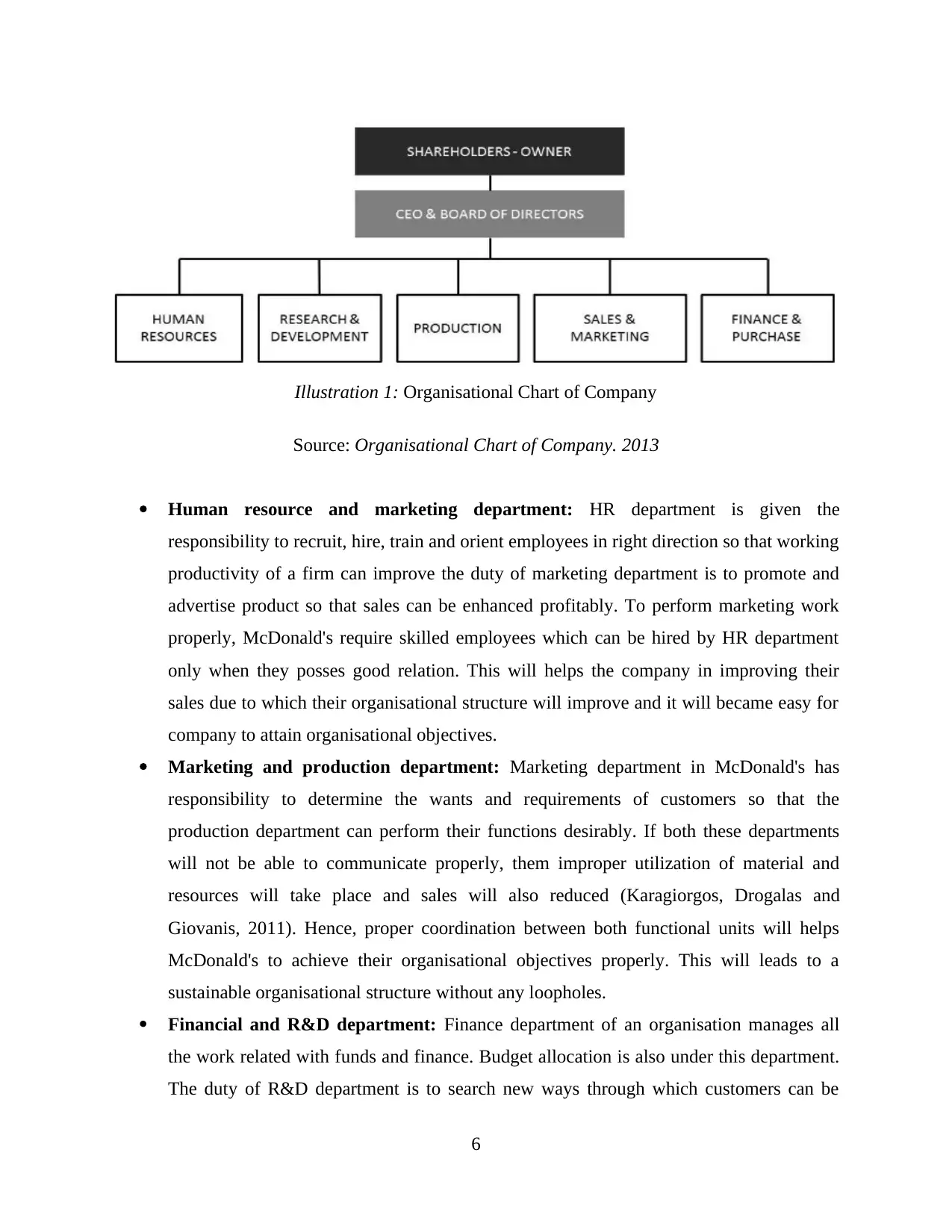
Illustration 1: Organisational Chart of Company
Source: Organisational Chart of Company. 2013
Human resource and marketing department: HR department is given the
responsibility to recruit, hire, train and orient employees in right direction so that working
productivity of a firm can improve the duty of marketing department is to promote and
advertise product so that sales can be enhanced profitably. To perform marketing work
properly, McDonald's require skilled employees which can be hired by HR department
only when they posses good relation. This will helps the company in improving their
sales due to which their organisational structure will improve and it will became easy for
company to attain organisational objectives.
Marketing and production department: Marketing department in McDonald's has
responsibility to determine the wants and requirements of customers so that the
production department can perform their functions desirably. If both these departments
will not be able to communicate properly, them improper utilization of material and
resources will take place and sales will also reduced (Karagiorgos, Drogalas and
Giovanis, 2011). Hence, proper coordination between both functional units will helps
McDonald's to achieve their organisational objectives properly. This will leads to a
sustainable organisational structure without any loopholes.
Financial and R&D department: Finance department of an organisation manages all
the work related with funds and finance. Budget allocation is also under this department.
The duty of R&D department is to search new ways through which customers can be
6
Source: Organisational Chart of Company. 2013
Human resource and marketing department: HR department is given the
responsibility to recruit, hire, train and orient employees in right direction so that working
productivity of a firm can improve the duty of marketing department is to promote and
advertise product so that sales can be enhanced profitably. To perform marketing work
properly, McDonald's require skilled employees which can be hired by HR department
only when they posses good relation. This will helps the company in improving their
sales due to which their organisational structure will improve and it will became easy for
company to attain organisational objectives.
Marketing and production department: Marketing department in McDonald's has
responsibility to determine the wants and requirements of customers so that the
production department can perform their functions desirably. If both these departments
will not be able to communicate properly, them improper utilization of material and
resources will take place and sales will also reduced (Karagiorgos, Drogalas and
Giovanis, 2011). Hence, proper coordination between both functional units will helps
McDonald's to achieve their organisational objectives properly. This will leads to a
sustainable organisational structure without any loopholes.
Financial and R&D department: Finance department of an organisation manages all
the work related with funds and finance. Budget allocation is also under this department.
The duty of R&D department is to search new ways through which customers can be
6
⊘ This is a preview!⊘
Do you want full access?
Subscribe today to unlock all pages.

Trusted by 1+ million students worldwide

satisfied desirably. For this, they require capital which will be granted by finance
department. If relation between both department will be healthy, it will be easier for them
to work in a unified way. This will help McDonald's in their organisational objectives and
targets in an efficient manner. Due to effective working, organisational structure will also
become robust.
Advantage: Good relation between teams will help the employees to trust each other
while performing work activities due to which overall productivity of firm will enhance. This
will also benefits in satisfying and serving the needs of customers in a proper way as all the tasks
will be carried out in organised manner. Good relation will ensure that less conflicts and issues
will take place between different departments and teams.
Disadvantage: More interaction between different departments can leads to confusion and
over-rule due to which working morale of employees can disrupt. Time taken for decision
making will also increase as different departments will give their different opinions due to
effective interrelation. Also, interdependence will increase which will decrease the work
performance of each department in McDonald's.
Organisational structure specifies the type according to which a company perform its
business operations. McDonald's follow divisional organisational structure in which each
division or unit manages a particular operational area. This organisational structure aims to
sustain organisational flexibility and autonomy. This structure helps the company to sustain their
business and operations at global level. Also, as work is carried out in divisions, formulating and
implementing strategies is become easier. But this organisational structure offer limited
flexibility to the company due to which changing performing work in some situations become
hard (Khan and Quaddus, 2015).
TASK 3
P4 Positive and negative impact of Macro-environment upon business operations
To perform macro-environmental analysis in an appropriate manner, PESTLE analysis
can be used. It will help the manager in McDonald's to identify political, economical, social,
technological, environmental and legal factors in a desired way. This will benefits the company
7
department. If relation between both department will be healthy, it will be easier for them
to work in a unified way. This will help McDonald's in their organisational objectives and
targets in an efficient manner. Due to effective working, organisational structure will also
become robust.
Advantage: Good relation between teams will help the employees to trust each other
while performing work activities due to which overall productivity of firm will enhance. This
will also benefits in satisfying and serving the needs of customers in a proper way as all the tasks
will be carried out in organised manner. Good relation will ensure that less conflicts and issues
will take place between different departments and teams.
Disadvantage: More interaction between different departments can leads to confusion and
over-rule due to which working morale of employees can disrupt. Time taken for decision
making will also increase as different departments will give their different opinions due to
effective interrelation. Also, interdependence will increase which will decrease the work
performance of each department in McDonald's.
Organisational structure specifies the type according to which a company perform its
business operations. McDonald's follow divisional organisational structure in which each
division or unit manages a particular operational area. This organisational structure aims to
sustain organisational flexibility and autonomy. This structure helps the company to sustain their
business and operations at global level. Also, as work is carried out in divisions, formulating and
implementing strategies is become easier. But this organisational structure offer limited
flexibility to the company due to which changing performing work in some situations become
hard (Khan and Quaddus, 2015).
TASK 3
P4 Positive and negative impact of Macro-environment upon business operations
To perform macro-environmental analysis in an appropriate manner, PESTLE analysis
can be used. It will help the manager in McDonald's to identify political, economical, social,
technological, environmental and legal factors in a desired way. This will benefits the company
7
Paraphrase This Document
Need a fresh take? Get an instant paraphrase of this document with our AI Paraphraser
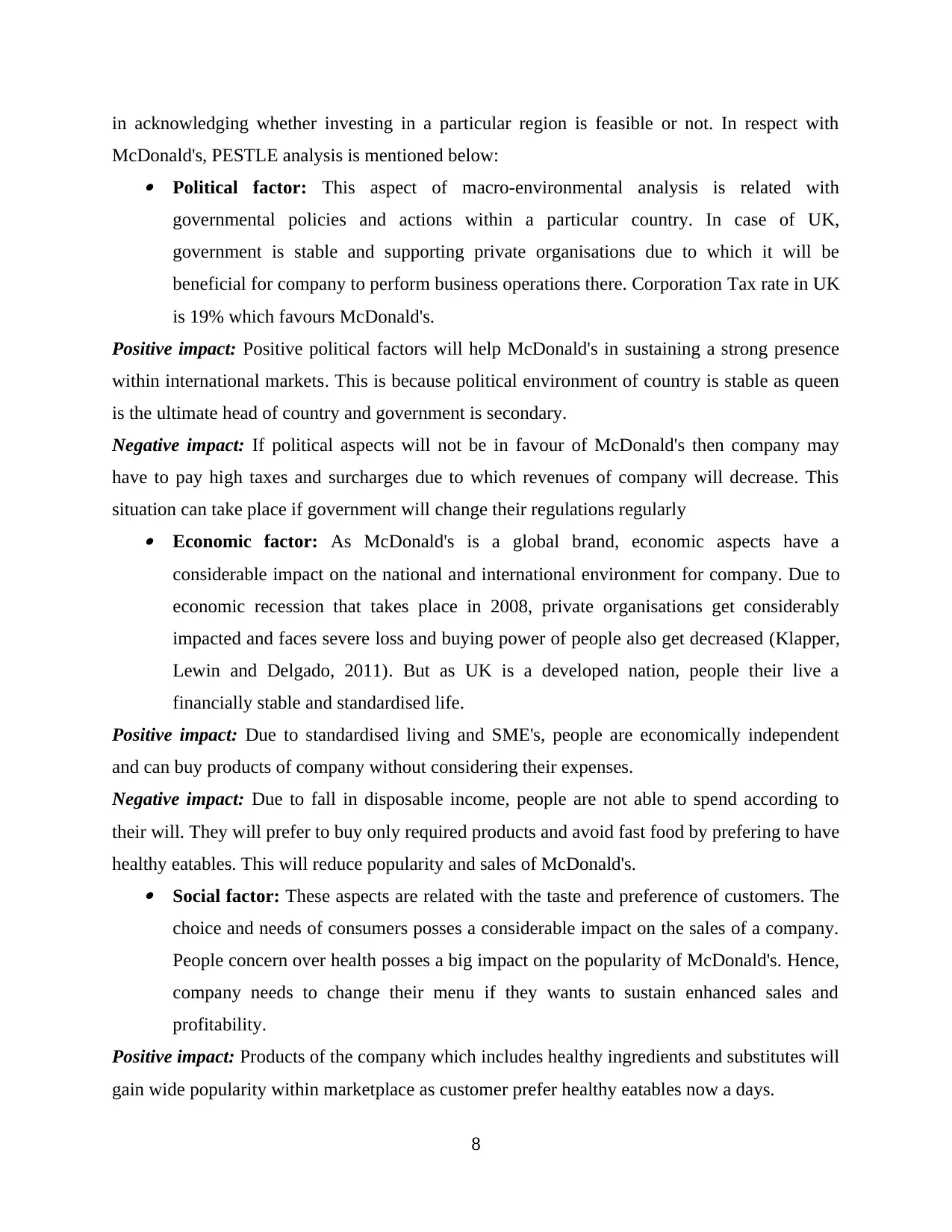
in acknowledging whether investing in a particular region is feasible or not. In respect with
McDonald's, PESTLE analysis is mentioned below: Political factor: This aspect of macro-environmental analysis is related with
governmental policies and actions within a particular country. In case of UK,
government is stable and supporting private organisations due to which it will be
beneficial for company to perform business operations there. Corporation Tax rate in UK
is 19% which favours McDonald's.
Positive impact: Positive political factors will help McDonald's in sustaining a strong presence
within international markets. This is because political environment of country is stable as queen
is the ultimate head of country and government is secondary.
Negative impact: If political aspects will not be in favour of McDonald's then company may
have to pay high taxes and surcharges due to which revenues of company will decrease. This
situation can take place if government will change their regulations regularly Economic factor: As McDonald's is a global brand, economic aspects have a
considerable impact on the national and international environment for company. Due to
economic recession that takes place in 2008, private organisations get considerably
impacted and faces severe loss and buying power of people also get decreased (Klapper,
Lewin and Delgado, 2011). But as UK is a developed nation, people their live a
financially stable and standardised life.
Positive impact: Due to standardised living and SME's, people are economically independent
and can buy products of company without considering their expenses.
Negative impact: Due to fall in disposable income, people are not able to spend according to
their will. They will prefer to buy only required products and avoid fast food by prefering to have
healthy eatables. This will reduce popularity and sales of McDonald's. Social factor: These aspects are related with the taste and preference of customers. The
choice and needs of consumers posses a considerable impact on the sales of a company.
People concern over health posses a big impact on the popularity of McDonald's. Hence,
company needs to change their menu if they wants to sustain enhanced sales and
profitability.
Positive impact: Products of the company which includes healthy ingredients and substitutes will
gain wide popularity within marketplace as customer prefer healthy eatables now a days.
8
McDonald's, PESTLE analysis is mentioned below: Political factor: This aspect of macro-environmental analysis is related with
governmental policies and actions within a particular country. In case of UK,
government is stable and supporting private organisations due to which it will be
beneficial for company to perform business operations there. Corporation Tax rate in UK
is 19% which favours McDonald's.
Positive impact: Positive political factors will help McDonald's in sustaining a strong presence
within international markets. This is because political environment of country is stable as queen
is the ultimate head of country and government is secondary.
Negative impact: If political aspects will not be in favour of McDonald's then company may
have to pay high taxes and surcharges due to which revenues of company will decrease. This
situation can take place if government will change their regulations regularly Economic factor: As McDonald's is a global brand, economic aspects have a
considerable impact on the national and international environment for company. Due to
economic recession that takes place in 2008, private organisations get considerably
impacted and faces severe loss and buying power of people also get decreased (Klapper,
Lewin and Delgado, 2011). But as UK is a developed nation, people their live a
financially stable and standardised life.
Positive impact: Due to standardised living and SME's, people are economically independent
and can buy products of company without considering their expenses.
Negative impact: Due to fall in disposable income, people are not able to spend according to
their will. They will prefer to buy only required products and avoid fast food by prefering to have
healthy eatables. This will reduce popularity and sales of McDonald's. Social factor: These aspects are related with the taste and preference of customers. The
choice and needs of consumers posses a considerable impact on the sales of a company.
People concern over health posses a big impact on the popularity of McDonald's. Hence,
company needs to change their menu if they wants to sustain enhanced sales and
profitability.
Positive impact: Products of the company which includes healthy ingredients and substitutes will
gain wide popularity within marketplace as customer prefer healthy eatables now a days.
8
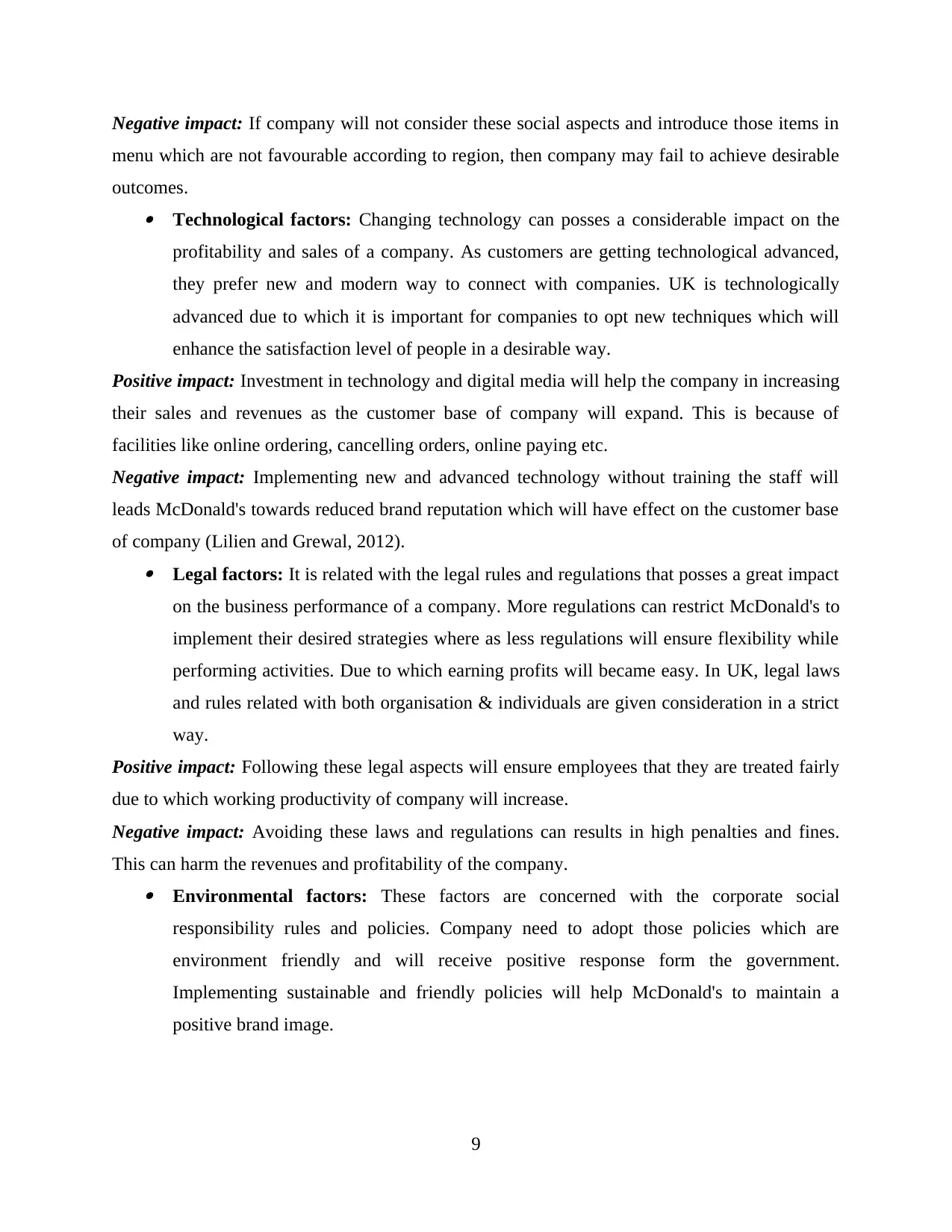
Negative impact: If company will not consider these social aspects and introduce those items in
menu which are not favourable according to region, then company may fail to achieve desirable
outcomes. Technological factors: Changing technology can posses a considerable impact on the
profitability and sales of a company. As customers are getting technological advanced,
they prefer new and modern way to connect with companies. UK is technologically
advanced due to which it is important for companies to opt new techniques which will
enhance the satisfaction level of people in a desirable way.
Positive impact: Investment in technology and digital media will help the company in increasing
their sales and revenues as the customer base of company will expand. This is because of
facilities like online ordering, cancelling orders, online paying etc.
Negative impact: Implementing new and advanced technology without training the staff will
leads McDonald's towards reduced brand reputation which will have effect on the customer base
of company (Lilien and Grewal, 2012). Legal factors: It is related with the legal rules and regulations that posses a great impact
on the business performance of a company. More regulations can restrict McDonald's to
implement their desired strategies where as less regulations will ensure flexibility while
performing activities. Due to which earning profits will became easy. In UK, legal laws
and rules related with both organisation & individuals are given consideration in a strict
way.
Positive impact: Following these legal aspects will ensure employees that they are treated fairly
due to which working productivity of company will increase.
Negative impact: Avoiding these laws and regulations can results in high penalties and fines.
This can harm the revenues and profitability of the company. Environmental factors: These factors are concerned with the corporate social
responsibility rules and policies. Company need to adopt those policies which are
environment friendly and will receive positive response form the government.
Implementing sustainable and friendly policies will help McDonald's to maintain a
positive brand image.
9
menu which are not favourable according to region, then company may fail to achieve desirable
outcomes. Technological factors: Changing technology can posses a considerable impact on the
profitability and sales of a company. As customers are getting technological advanced,
they prefer new and modern way to connect with companies. UK is technologically
advanced due to which it is important for companies to opt new techniques which will
enhance the satisfaction level of people in a desirable way.
Positive impact: Investment in technology and digital media will help the company in increasing
their sales and revenues as the customer base of company will expand. This is because of
facilities like online ordering, cancelling orders, online paying etc.
Negative impact: Implementing new and advanced technology without training the staff will
leads McDonald's towards reduced brand reputation which will have effect on the customer base
of company (Lilien and Grewal, 2012). Legal factors: It is related with the legal rules and regulations that posses a great impact
on the business performance of a company. More regulations can restrict McDonald's to
implement their desired strategies where as less regulations will ensure flexibility while
performing activities. Due to which earning profits will became easy. In UK, legal laws
and rules related with both organisation & individuals are given consideration in a strict
way.
Positive impact: Following these legal aspects will ensure employees that they are treated fairly
due to which working productivity of company will increase.
Negative impact: Avoiding these laws and regulations can results in high penalties and fines.
This can harm the revenues and profitability of the company. Environmental factors: These factors are concerned with the corporate social
responsibility rules and policies. Company need to adopt those policies which are
environment friendly and will receive positive response form the government.
Implementing sustainable and friendly policies will help McDonald's to maintain a
positive brand image.
9
⊘ This is a preview!⊘
Do you want full access?
Subscribe today to unlock all pages.

Trusted by 1+ million students worldwide
1 out of 17
Related Documents
Your All-in-One AI-Powered Toolkit for Academic Success.
+13062052269
info@desklib.com
Available 24*7 on WhatsApp / Email
![[object Object]](/_next/static/media/star-bottom.7253800d.svg)
Unlock your academic potential
Copyright © 2020–2025 A2Z Services. All Rights Reserved. Developed and managed by ZUCOL.





